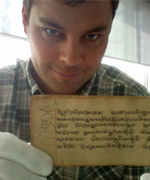Translation: Fidelity vs Innovation
As translators we create new texts while striving to transmit the authenticity of the original. What constitutes an authentic translation? Throughout the history of Buddhism in Tibet and across Asia, adaptation, assimilation, and innovation have been essential to the persistence and continued relevance of texts and the contents they transmit. As translators, do we bear responsibility for fidelity to our texts? To our readers? To “the tradition”? To what degree may we innovate in the work that we do? In sum, what are the ethics of representation in our translation work, and how do we balance our fidelity to the past with our allegiance to the present?
Event: TT Conference 2017 – Discussion Session
Date: June 1, 2017 – 2:30 pm
Facilitators: Andrew Quintmen, Dan Hirshberg
Topics: Fidelity, Innovation, Translation

Dan Hirshberg
University of Mary Washington; Nitartha Translation Network
Dan Hirshberg is assistant professor of religion at the University of Mary Washington in Fredericksburg, VA, where he directs the Contemplative Studies program. He received his PhD in Tibetan Buddhism and Historiography from Harvard University, and recently published the revision of his dissertation as Remembering the Lotus-Born: Padmasambhava in the History of Tibet’s Golden Age (Wisdom Publications, 2016). Dan is an active member of the Nitartha Translation Network, and continues to work on the evolution of the Padmasambhava Bka’ thang literature and its core topoi, such as the renowned “eight names of the guru.”

Andrew Quintman
Yale University
Quintman is associate professor in the Department of Religious Studies at Yale University, specializing in the Buddhist traditions of Tibet and the Himalaya. For seven years he served as the academic director of the School for International Training’s Tibetan Studies program based in Kathmandu. He is the author of The Yogin and the Madman: Reading the Biographical Corpus of the Great Tibetan Saint Milarepa (Columbia University Press, 2014). His English translation of The Life of Milarepa (2010) was published in the Penguin Classics series. He is currently writing a history of Drakar Taso Monastery in Tibet southern borderland and a study of the Buddha’s life story through the visual and literary materials of Jonang Monastery in western Tibet.
